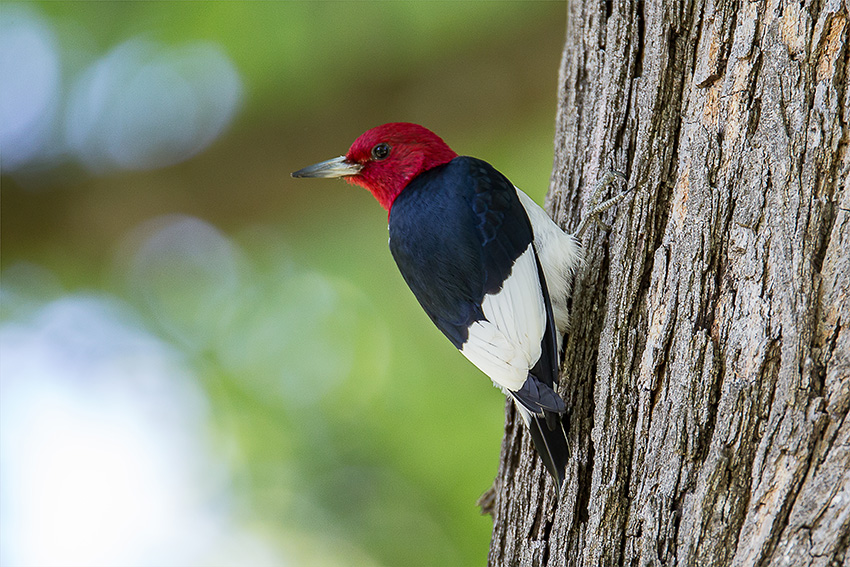Woodpecker Control
Do you need to get rid of woodpeckers? We can help!

Woodpecker Removal Strategies
Most of the time, it is great to have a woodpecker around. They typically peck on dying trees. They drill about 100 pecks a minute, and their sticky tongue catches insects like carpenter ants before they can move to healthy trees. However, woodpeckers will also peck on utility poles, wood siding, barns, and other wooden structures in search of insects.
Woodpeckers can quickly do a lot of damage to a home. It isn’t uncommon to find clusters of holes in wood siding or fences where the bird has been searching for insect larvae or other food. During courtship, homes are even more vulnerable because all the bird needs is a structure for “drumming” to declare territory and find a mate. Woodpeckers will frantically peck anything from gutters to vents to chimney caps; the resulting noise can be a huge nuisance for homeowners, and there’s always the possibility that property will be damaged as well.
If woodpeckers get comfortable on your property, it can be tough to get rid of them. These birds are federally protected, and methods to deter them often involve using loud noises and unsightly visual repellants, which can be just as annoying as the woodpeckers themselves. That’s why your best option is to call Trutech. We’ve spent years developing ethical and environmentally-friendly woodpecker capture and woodpecker removal techniques that work. Our licensed specialists provide Trutech customers with long-lasting solutions that fix the problem and preventative measures that prevent future issues. Need to deal with a pesky woodpecker? Reach out to Trutech today.
Woodpecker Problem

Signs a Woodpecker is on Your Property
No one can mistake the loud, rhythmic drumming of the woodpecker. These small birds use their bills to strike away at wood to find food. Generally, woodpeckers will look for insects in dying tree trunks, but they won’t hesitate to drill holes in man-made structures made of cedar, pine, and even synthetic stucco. These materials are softer than hardwoods like oak, making it easy for these birds to batter out nesting holes or hunt for their prey.

Dangers of Woodpecker Infestation
Drumming behavior is annoying and causes damage to the material used. Holes and dents, some as large as an inch across, will be clustered in the pecking zone. Woodpeckers often destroy wood siding on homes while searching for the larvae of the large black carpenter bees that drill holes in the spring. These birds can also make nesting holes in the sides of houses. This is especially true if the house is made of dark wood or has dark stain, has natural wood or shake shingles, or is near heavily wooded areas. Woodpeckers also target barns and other wooden outbuildings.
Humane Woodpecker Removal & Control Strategies

Entry into property
Woodpeckers don’t just peck to find food and build nests, they also do it to make noise to find mates and declare their territory. This behavior is called drumming, and houses are sometimes the instruments of choice. The birds are attracted to all kinds of home siding, fascia boards, trim pieces, gutters, downspouts, chimneys, and vents.

Trapping & Removal
As migratory, nongame birds, woodpeckers are protected by the Federal Migratory Bird Treaty Act. Two species, the red-cockaded woodpecker and the ivory-billed woodpecker, are even on the endangered list. State and federal permits are typically required for any trapping activity. Homeowners’ best option is to contact a professional wildlife removal service. Choose the licensed and experienced team at Trutech to reliably rid your property of woodpeckers that have become pests.

Prevention & Exclusion
The key to successful woodpecker prevention is to act as soon as problem behavior starts and to keep up the remedy until the birds relocate. Anything less and the behavior will become habit, which is much harder to control. To keep woodpeckers from pecking or drumming, homeowners can attempt to cover surfaces with mesh, metal, or cloth. The pests might also be redirected if a wooden box is placed in a more desirable location nearby. Individuals can also try visual repellents such as hanging pinwheels, mirrors, balloons, or long strips of foil near problem sites. A variety of noisemaking options exist, including aluminum pie plates, metal can lids, loud radios, or recorded calls of birds of prey.


